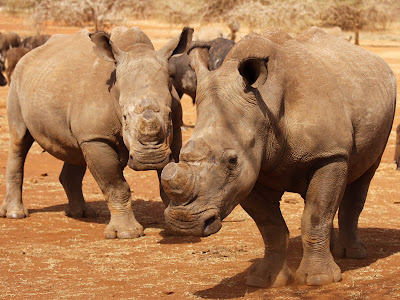
The
Komodo dragon, Varanus komodoensis, also known as the Komodo monitor, is a large species of lizard found in the Indonesian islands of Komodo, Rinca, Flores, Gili Motang and Gili Dasami. A member of the monitor lizard family (Varanidae), it is the largest living species of lizard, growing to a maximum of length 3 metres (9.8 ft) in rare cases and weighing up to around 70 kilograms (150 lb). Their unusual size has been attributed to island gigantism, since there are no other carnivorous animals to fill the niche on the islands where they live.
However, recent research suggests that the large size of komodo dragons may be better understood as representative of a relict population of very large varanid lizards that once lived across Indonesia and Australia, most of which, along with other megafauna, died out after the Pleistocene. Fossils very similar to V. komodoensis have been found in Australia dating to greater than 3.8 million years ago, and its body size remained stable on Flores, one of the handful of Indonesian islands where it is currently found, over the last 900,000 years, "a time marked by major faunal turnovers, extinction of the island's megafauna, and the arrival of early hominids by 880 ka."
As a result of their size, these lizards dominate the ecosystems in which they live. Komodo dragons hunt and ambush prey including invertebrates, birds, and mammals. Their group behaviour in hunting is exceptional in the reptile world. The diet of big Komodo dragons mainly consists of deer, though they also eat considerable amounts of carrion.
Mating begins between May and August, and the eggs are laid in September. About twenty eggs are deposited in abandoned megapode nests or in a self-dug nesting hole. The eggs are incubated for seven to eight months, hatching in April, when insects are most plentiful. Young Komodo dragons are vulnerable and therefore dwell in trees, safe from predators and cannibalistic adults. They take about eight to nine years to mature, and are estimated to live for up to 30 years.
Komodo dragons were first recorded by Western scientists in 1910. Their large size and fearsome reputation make them popular zoo exhibits. In the wild their range has contracted due to human activities and they are listed as vulnerable by the IUCN. They are protected under Indonesian law, and a national park, Komodo National Park, was founded to aid protection efforts.
The Komodo dragon is also known as the Komodo monitor or the Komodo Island monitor in scientific literature, although this is not very common. To the natives of Komodo Island, it is referred to as ora, buaya darat (land crocodile) or biawak raksasa (giant monitor).







 Perform dental treatment may work against ordinary human beings. But what if the check is the teeth of a lion? This is precisely what a number of doctors and nurses at a veterinary clinic in Medellin, Colombia, on Thursday (15 / 9). It took a number of medical personnel to treat dental Tyson was named king of the jungle. The 20-year-old lion everyday lives in Santafe Zoo in Medellin. (Photo: REUTERS / Albeiro Lopera)
Perform dental treatment may work against ordinary human beings. But what if the check is the teeth of a lion? This is precisely what a number of doctors and nurses at a veterinary clinic in Medellin, Colombia, on Thursday (15 / 9). It took a number of medical personnel to treat dental Tyson was named king of the jungle. The 20-year-old lion everyday lives in Santafe Zoo in Medellin. (Photo: REUTERS / Albeiro Lopera)




















































